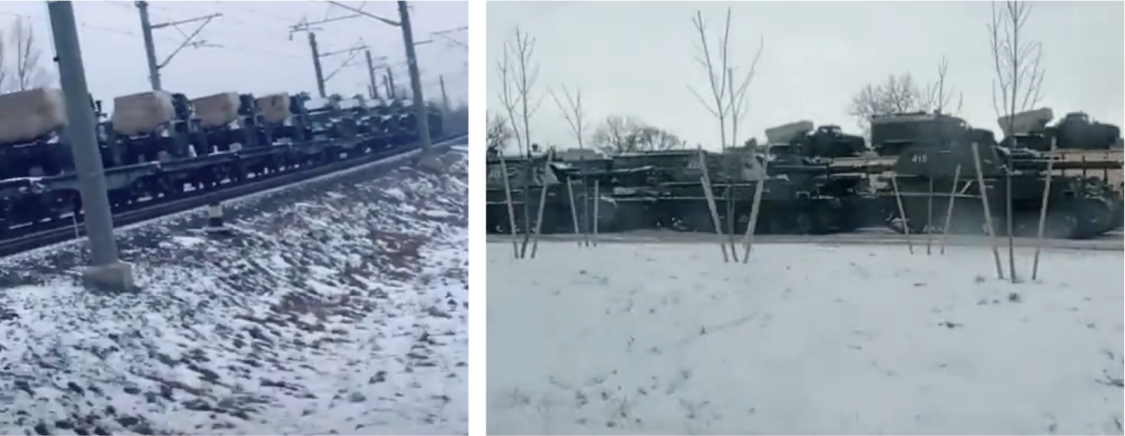Russian equipment flows into Belarus
Russia continues to move tanks and other materiel into Belarus along Ukraine’s northern border, as far west as Brest.
Russian equipment flows into Belarus
Share this story
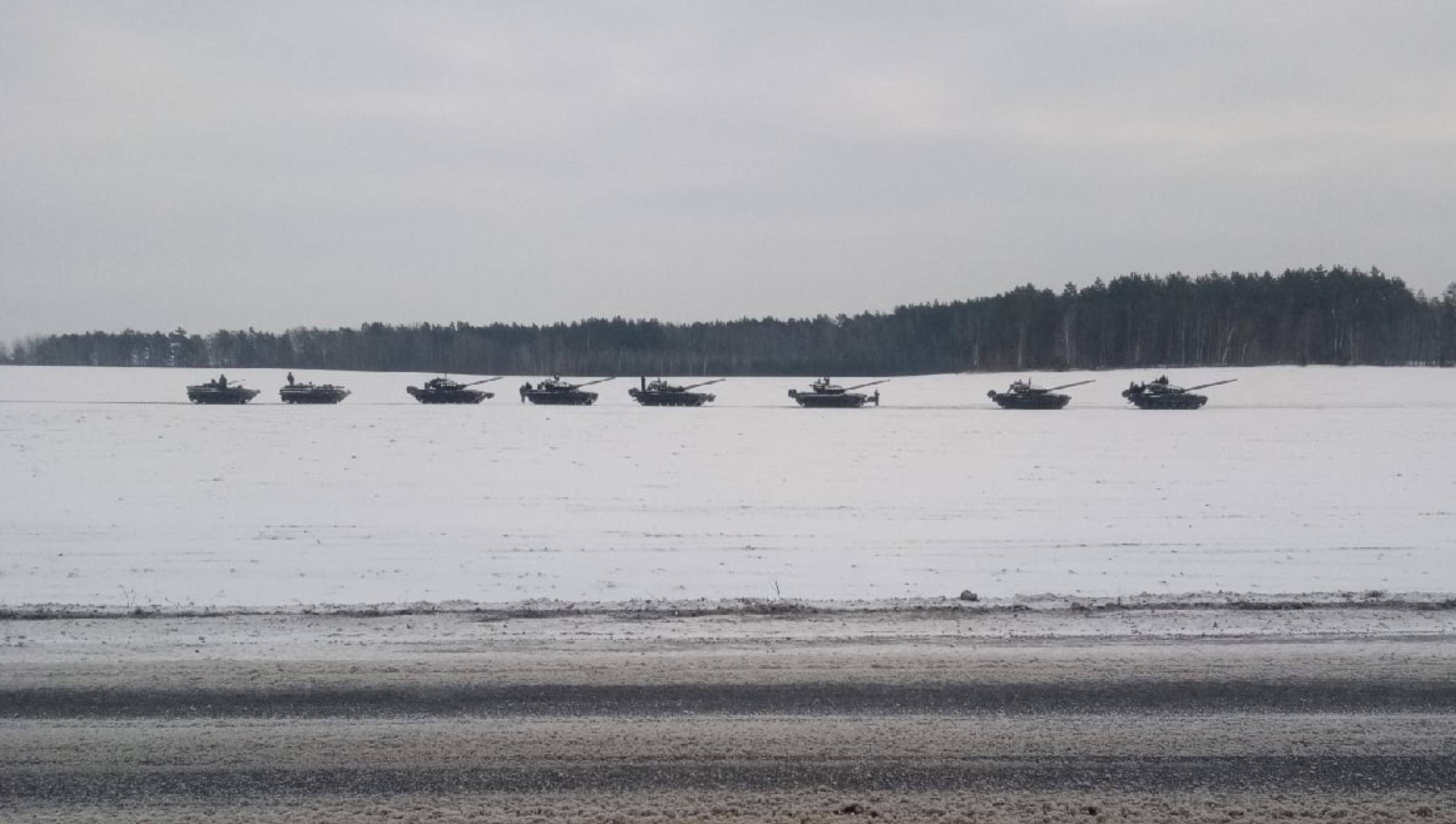
BANNER: Screencap of video showing Russian armor in a field near Rechitsa. (Source: VK)
The DFRLab has tracked military equipment arriving in Gomel and Brest Oblasts, in southeastern and southwestern Belarus respectively, as well as a resumption of equipment arriving near Russia’s border with northern Ukraine. While Russia claims that the equipment is in Belarus for upcoming joint exercises, the units spotted in Gomel Oblast are nowhere near known training areas and, instead, appear to be congregating in temporary camps in open fields.
While the flow of military equipment into Belarus from the Russian Eastern Military District continues, there has been a resurgence in activity in Russia’s Smolensk and Voronezh Oblasts, and to some extent Bryansk Oblast. Notably, the 4th Tank Division appears to have resumed its movement from Moscow to the Pogonovo training grounds south of Voronezh after a lull in December 2021 and early January 2022.
This article is intended as a snapshot of the buildup of Russian forces over the past week, particularly in Belarus. Not all aspects of the buildup, such as aviation assets, short-range ballistic missiles, and the arrival of the 217th Airborne Regiment, are discussed.

Rechitsa
Over the past week, extraordinary amounts of footage have emerged from Rechitsa station, in part due to its location in the city center and in part due to the volume of equipment arriving there. Rechitsa is approximately 60 km from the Ukrainian border and 300 km due north of Kyiv. Using open sources, the DFRLab identified equipment arriving from the 5th Tank Brigade in Ulan-Ude and the 37th Motor-Rifle Brigade in Kyakhta, both part of the 36th Combined Arms Army in the Buryat Republic, south of Lake Baikal.
On January 20, a video was uploaded showing five T-72B3 main battle tanks arriving at Rechitsa station. Analysis of their tactical marks revealed that they were from the 37th Motor-Rifle Brigade in Kyakhta. This was visible from archival footage of the brigade taking part in preparations for the “Tank Biathlon,” which Russia hosts on a yearly basis. Also visible on the train were four BMP-2 infantry fighting vehicles, as well as some medical armored vehicles.
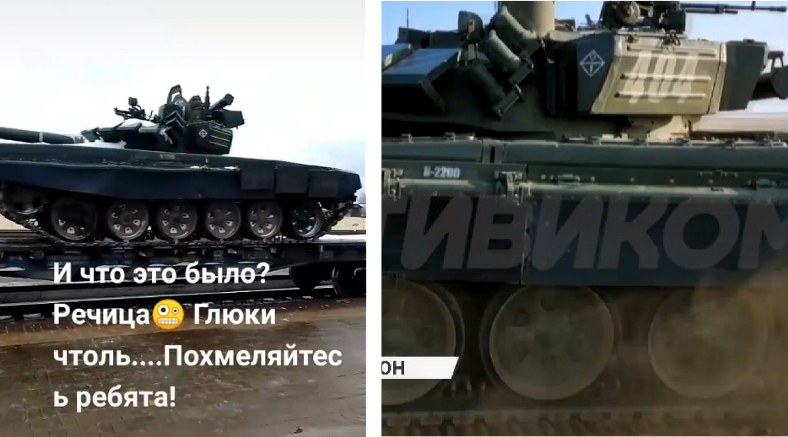
On January 21, another video surfaced of a train in nearby Gomel carrying 10 BMP-2s, a Strela-10 short-range air defense missile system, as well as other equipment. Many videos of Rechitsa station show large amounts of unidentifiable BMP-2s that may either be from the 37th MRB or the 5th Tank Brigade.
Now-deleted footage showed a train carrying 34 BMP-2s and one ZSU-23–4 “Shilka” self-propelled air defense system. This amount of infantry fighting vehicles make up the better part of a motor-rifle battalion. Other footage showed upwards of eighteen 2S3 152mm self-propelled howitzers and twelve BM-21 Multiple Launch Rockets Systems as potentially having arrived from the 37th MRB. These are some of the more common artillery systems observed moving to Belarus from the Eastern Military District, along with 2S1s and BM-27s.
On January 22, a train carrying about 30 T-72s of different variants appeared at Rechitsa. This is the equivalent to a tank battalion, of which there commonly are three in a tank brigade. The tanks bore the tactical markings of the 5th Tank Brigade in Ulan-Ude. The DFRLab compared markings to tanks participating in exercises at a newly opened training area near Ulan-Ude to reach a positive match.
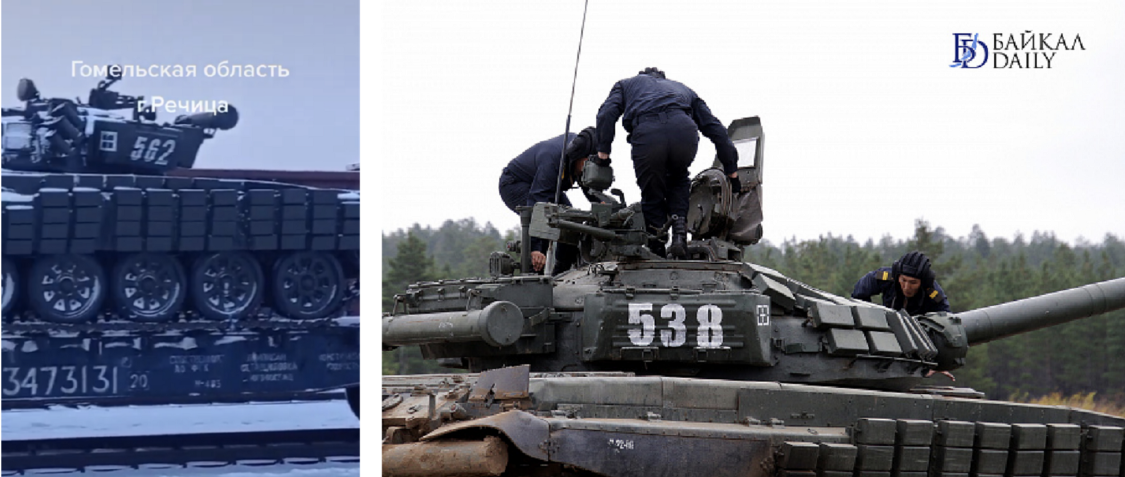
The DFRLab observed at least one other train carrying a battalion of T-72s from the 5th Tank Brigade from Ulan-Ude to arrive at Rechitsa station. A separate video, now deleted, showed 14 BMP-2s from the 5th Tank Brigade stopped at Rechitsa station. A few other videos show additional tanks and other specialized equipment like Borisoglebsk-2 electronic warfare systems and MTU-72 armored bridge layers. At the time of publishing, the DFRLab estimates that a total of 71 T-72 tanks of different variants have arrived at Rechitsa, based on available open-source evidence.
Equipment arriving at Rechitsa appeared to move south after unloading at the station. This is evidenced by several pieces of open-source footage showing columns of armored vehicles moving through fields towards the M-10 highway.

Sentinel-1 synthetic aperture radar (SAR) imagery suggests that the equipment has gathered in smaller camps fields surrounding a patch of forest south of the M-10 by Rechitsa. Sentinel-2 imagery appeared to confirm that the changes observed by Sentinel-1 were in fact military camps, as imagery from January 20 showed tire tracks in the direction of the new camps. A camp of BM-27s was previously observed in this area, but appears to have relocated prior to the first SAR capture of the suspected camps on January 23.
Mazyr
Equipment believed to originate from the 64th Motor-Rifle Brigade in Khabarovsk was spotted moving to Mazyr, 50 km north of the Ukrainian border, and departing the station in a southward direction toward Ukraine. A video posted on January 22 showed a train carrying 10 BMP-2 IFVs and 13 T-80BVM main battle tanks move through Rechitsa westward. Footage posted to TikTok the following day revealed the T-80BVMs along with 2S1 122mm self-propelled howitzers driving through the village of Kamenka, south of Mazyr.
A few days later, footage emerged of seven BM-27s along with transporter-loaders moving on R-31 towards Mazyr from the north. Twitter user @Danspiun tied the vehicles to the 165th Artillery Brigade, which had previously been identified by Conflict Intelligence Team as sending BM-27s to Belarus.
Another train tied to the 165th Artillery Brigade recently arrived at Mazyr, carrying additional transporter-loaders along with a Zoopark-1 counter-battery radar.
Twitter user @danvan71 pointed out a location in the forest near where the T-80BVMs were previously spotted as a likely location for a developing military camp. Sentinel-1 imagery from January 16, 23, and 26 showed evolving changes on the ground that could point to the presence of a military camp.

Yelsk
On January 19, pro-government media in Belarus published footage of the 38th Motor-Rifle brigade arriving in Yelsk, less than 20 km from the Belarusian border with Ukraine.
Several other videos surfaced on TikTok showing trains with equipment from the 38th Motor-Rifle Brigade on their way to Yelsk. The equipment was identifiable by the upward facing triangle which at times Russian soldiers painted over along with their tactical numbers.

On January 23, Belarusian news outlet MotolkoHelp published imagery of BM-21 122mm rocket artillery at Yelsk station.
Brest
On January 18, the Belarusian military’s official YouTube channel ВоенТВ Беларуси posted a video showing military echelons arriving in Belarus.
Twitter user @Danspiun suggested that the video had been recorded in Brest, approximately 50 km from Ukraine’s northwest border. Geolocation by the DFRLab confirmed that the unloading of the military equipment took place in the southern part of Brest.
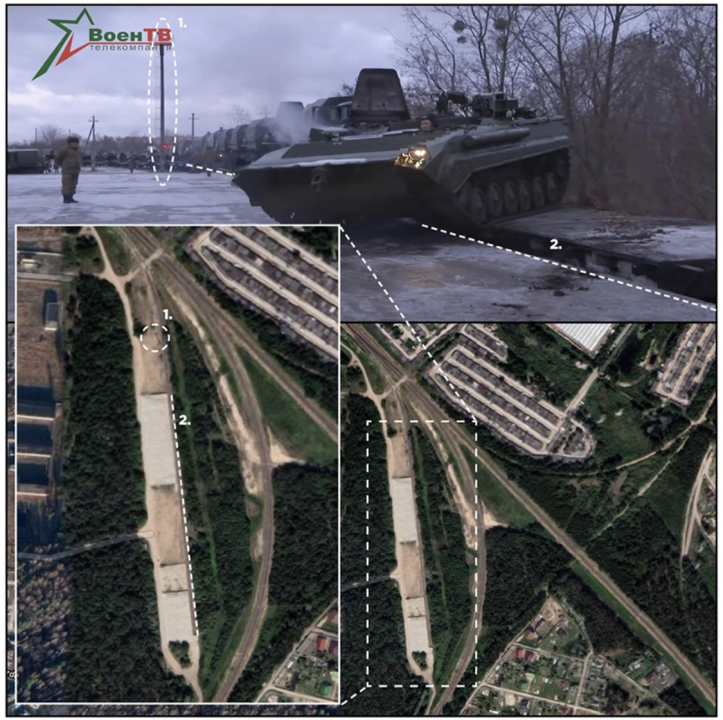
Additional videos surfaced on the same day across social media, taken by local Belarusians. In these videos, the military equipment was captured already unloaded, moving on the streets of Brest.
The geolocation of the first video showed that the video was taken on Druzhnaya Street (Дружная вуліца), right outside of the unloading platform.

Another video that surfaced on the same day captured the military vehicle echelon already on the move.
DFRLab geolocation of the video revealed that it was taken on the P17 road. The Russian vehicles in the video were moving northwards, possible toward the P94 road that leads to the main Brest military training grounds.

At the time of the analysis, it is unclear where these troops were deployed on Belarusian territory, yet they most likely headed towards the training grounds south of Brest. Additionally, satellite imagery on January 24 documented a large number of vehicle track marks, suggesting increased movement.
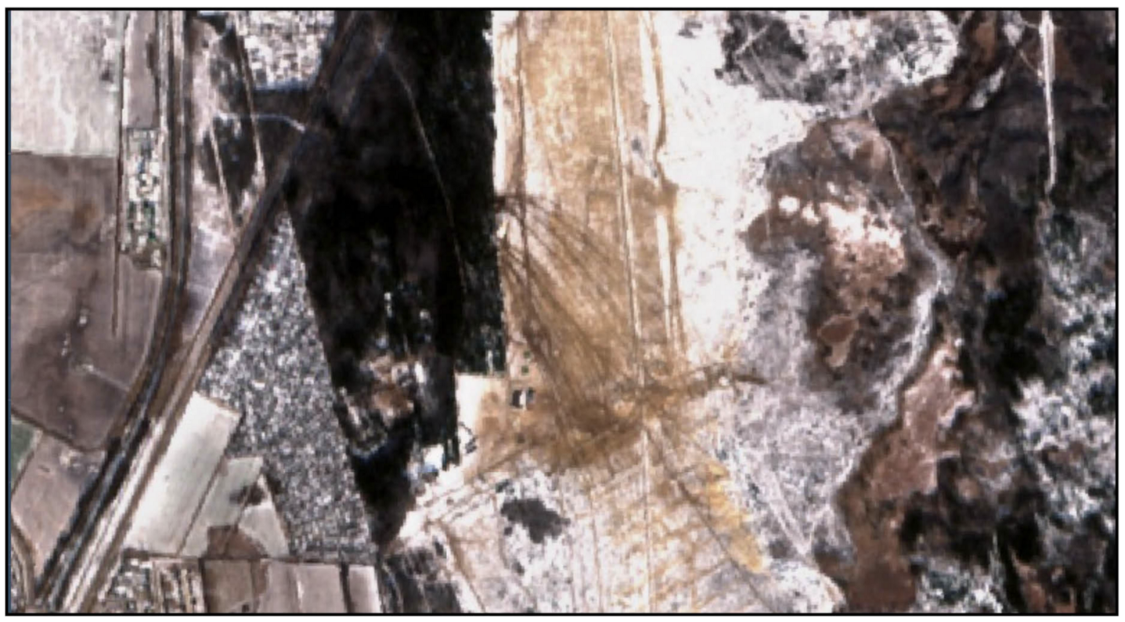
Judging by the military patches of the soldiers that were standing in formation in the video, this was the Russian 36th Separate Guards Motor Rifle Brigade. The video suggests that the unit is equipped with BMP-2 amphibious infantry fighting vehicle, T-72 main battle tanks and military trucks.

According to information gleaned from publicly available railway databases, these wagons came from Smolensk train station, which is located in western Russia. The 36th Brigade is permanently deployed in Borzya, Zabaykalsky Krai, in the Russian far east, yet Smolensk seems to be the local logistics hub.
Baranovichy
Russian Pacific Fleet’s 155th Naval Infantry Brigade (155th Brigade) has been recorded to be on the move early as January 14, 2022. The brigade is permanently deployed in Vladivostok, along Russia’s Pacific coast.
On January 17, the same brigade was documented traveling through the Voronezh region, northeast of Ukraine.
And on January 25, videos suggested that the echelon arrived in Belarus but did not identify its specific location.
On January 25, Motolko Help published photos suggesting that the 155th Brigade had reached its final destination. DFRLab geolocation confirmed that the troops unloaded their equipment at the Polonka train station, west of Baranovichy, approximately 200 km north of the Ukrainian border.

The unit was equipped with BMP-3 amphibious infantry fighting vehicles, T-80BV, MT-LB fully amphibious auxiliary armored tracked vehicles, and Nona-S light-weight self-propelled 120 mm gun-mortars. However, the most outstanding piece of equipment was the 9K33 Osa, a highly mobile, low-altitude, short-range tactical surface-to-air missile system, which has a range of 12 km.
Cite this case study:
Michael Sheldon and Lukas Andriukaitis, “Russian equipment flows into Belarus,” Digital Forensic Research Lab (DFRLab), January 27, 2022, https://dfrlab.org/2022/01/27/russian-equipment-flows-into-belarus/.

